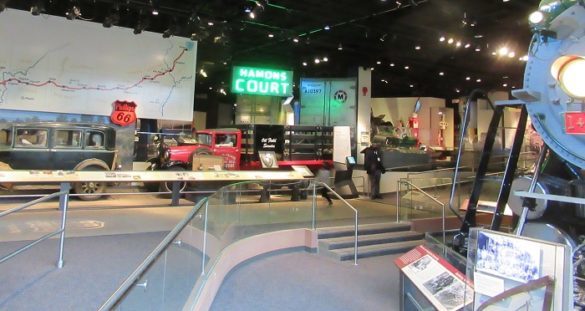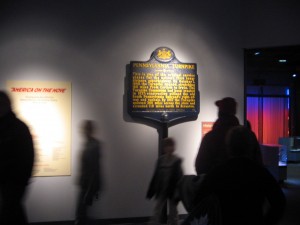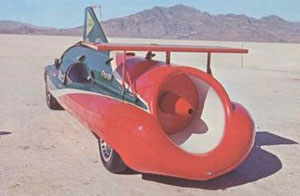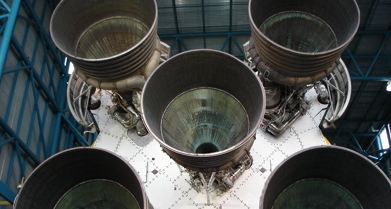by Bruce Wells | Nov 17, 2023 | Petroleum Transportation
The Smithsonian Institution’s National Museum of American History in Washington, D.C., has educated millions of visitors about America’s transportation history since “America on the Move” opened on the first floor in November 2003.
The General Motors Hall of Transportation exhibits include the 1903 Winton that was the first car to drive across the country; a 1959 Chicago Transit Authority “L” mass transit car; a 260-ton locomotive built in 1926; and the history U.S. Route 66 — the “People’s Highway.”
“America on the Move” also exhibits a 1931 red Ford truck representing oilfield service companies from Shawnee, Oklahoma.

An exhibit about the history of Route 66 — commissioned in 1926 and fully paved by the late 1930s — is part of the Transportation Hall at the National Museum of American History. Photo by Bruce Wells.
The $22 million Transportation Hall encompasses 26,000 square feet and displays more than 340 historic objects. The space features 19 historic settings in chronological order reflecting the nation’s relationship with great and small roadways.

“America on the Move replaces exhibits of road and rail transportation and civil engineering installed when the National Museum of American History opened as the Museum of History and Technology in 1964,” notes the American on the Move website page.
“We would not do an exhibit about cars and trains, or even a transportation history exhibit. It would be an exhibit about transportation in American history,” the site adds.

The Smithsonian’s exhibit includes the history behind creation of the interstate highway system. Photo by Bruce Wells.
“America on the Move” features the Smithsonian’s extensive transportation collection using multimedia technology — and a large displays, including PS-4 class steam locomotive (No. 1401) built in 1926. The exhibition educates visitors about the history of U.S. transportation infrastructure, and “reveals America’s fascination with life on the road.” (more…)
by Bruce Wells | Jul 5, 2023 | Petroleum Products
Highly refined propellant began as “coal oil” for lamps.
A 19th century petroleum product made America’s 1969 moon landing possible. On July 16, 1969, kerosene rocket fuel powered the first stage of the Saturn V of the Apollo 11 mission.
Four days after the Saturn V launched Apollo 11, astronaut Neil Armstrong announced, “Houston, Tranquility Base here. The Eagle has landed.” His historic achievement rested on new technologies – and tons of fuel first refined for lamps by a Canadian in 1848.

Powered by five first-stage engines fueled by “rocket grade” kerosene, the Saturn V remains the tallest, heaviest and most powerful rocket ever built.
During launch, five Rocketdyne F-1 engines of the massive Saturn V’s first stage burn “Rocket Grade Kerosene Propellant” at 2,230 gallons per second – generating almost eight million pounds of thrust.

The F-1 engines of the Saturn V first stage at the U.S. Space and Rocket Center in Huntsville, Alabama. Photos courtesy NASA.
Saturn’s rocket fuel is highly refined kerosene RP-1 (Rocket Propellant-1 or Refined Petroleum-1) which, while conforming to stringent performance specifications, is essentially the same “coal oil” invented in the mid-19th century.

Canadian physician and geologist Abraham Gesner began refining an illuminating fuel from coal in 1846. “I have invented and discovered a new and useful manufacture or composition of matter, being a new liquid hydrocarbon, which I denominate Kerosene,” he noted in his patent.

The father of American rocketry, Robert Goddard, in 1926 used gasoline to fuel the world’s first liquid-fuel rocket, seen here in its launch stand. Photo courtesy Library of Congress.
By 1850, Gesner had formed a company that installed lighting in the streets in Halifax, Nova Scotia. In 1854, he established the North American Kerosene Gas Light Company at Long Island, New York.
Although he had coined the term kerosene from the Greek word keros (wax), because his fluid was extracted from coal, most consumers called it “coal oil” as often as they called it kerosene.
By the time of the first U.S. oil well drilled by Edwin Drake in 1859, a Yale scientist (hired by the well’s investors) reported oil to be an ideal source for making kerosene, far better than refined coal. Demand for kerosene refined from petroleum launched the nation’s exploration and production industry.
Although electricity would replace kerosene lamps and gasoline dominate 20th century demand for a transportation fuel, kerosene has remained a power fuel choice.
Jet Car Racers
On November 7, 1965, California race car driver Art Arfons set the land-speed record at 576.553 miles per hour at Utah’s Bonneville Salt Flats. The Ohio drag racer’s home-made Green Monster was powered by JP-4 fuel (a 50-50 kerosene-gasoline blend), in an afterburner-equipped F-104 Starfighter turbojet jet engine.

A kerosene-gasoline blend powered the F-104 jet engine of the Green Monster to world records,.
Nathan Ostrich, who built of the first jet car in 1962, reached a speed in excess of 330 mph on the famous one-mile strip in his Flying Caduceus. His racer used a General Electric J47 engine originally designed for the North American F-86 Sabre jet fighter. Arfon set the world land-speed record three times between 1964 and 1965, in what became known as “The Bonneville Jet Wars.”
Record challenger Craig Breedlove’s Spirit of America Sonic 1 in 1965 used a jet engine from a an F-4 Phantom II to defeat the Green Monster and set a record of 600.601 mph, which lasted until 1970, when the Blue Flame Natural Gas Rocket Car reached 630.388 mph.
Kerosene Rockets
Kerosene’s ease of storage and stable properties attracted early rocket scientists like America’s Robert H. Goddard and Germany’s Wernher von Braun. During World War II, kerosene fueled Nazi Germany’s notorious V-2 ballistic missiles.

Decades of post-war rocket engine research and testing led to the Saturn V’s five Rocketdyne F-1 engines. “The F-1 remains the most powerful single-combustion chamber liquid-fueled rocket engine ever developed, according to David Woods, author of How Apollo Flew to the Moon, 2008.
The Rocketdyne F-1 engines, 19 feet tall with nozzles about 12 feet wide, include fuel pumps delivering 15,471 gallons of RP-1 per minute to their thrust chambers. The Saturn V’s upper stages burn highly volatile liquid hydrogen (and liquid oxygen in all three stages). The five-engine main booster hold 203,400 gallon of RP-1. After firing, the engines can empty the massive fuel tank in 165 seconds.

Kerosene fueled the Saturn V’s five main engines used for getting Apollo astronauts to the moon. NASA photo detail.
The Apollo 11 landing crowned liquid-rocket fuel research in America dating back to Goddard and his 1914 “Rocket Apparatus” powered by gasoline. In March 1926, Goddard launched the world’s first liquid-fuel rocket from his aunt’s farm in Auburn, Massachusetts.
Although gasoline will be replaced with other propellants, including the liquid hydrogen and liquid oxygen used in the space shuttle’s external tank, RP-1 kerosene continues to fuel spaceflight.
Cheaper, easily stored at room temperature, and far less of an explosive hazard, the 19th century petroleum product today fuels first-stage boosters for the Atlas, Delta II, Antares, and the latest SpaceX rockets. Reusable SpaceX Falcon 9 rockets have nine Merlin engines burning kerosene fuel and generating 1.7 million pounds of thrust.
Last launched in 1972, the Saturn V remains the most powerful rocket ever built.
_______________________
Recommended Reading: Stages to Saturn: A Technological History of the Apollo/Saturn Launch Vehicles (2003). As an Amazon Associate, AOGHS earns a commission from qualifying purchases.
(2003). As an Amazon Associate, AOGHS earns a commission from qualifying purchases.
_______________________
The American Oil & Gas Historical Society (AOGHS) preserves oil history. Become an AOGHS annual supporting member and help maintain this energy education website and expand historical research. For more information, contact bawells@aoghs.org. © 2023 Bruce A. Wells.
Citation Information – Article Title: “Kerosene Rocket Fuel.” Authors: B.A. Wells and K.L. Wells. Website Name: American Oil & Gas Historical Society. URL:https://aoghs.org/products/kerosene-rocket-fuel. Last Updated: July 5, 2023. Original Published Date: July 12, 2015.
by Bruce Wells | Jun 25, 2023 | Petroleum Art
National Museum of American History once featured oil derricks, pump jacks, and other oilfield technologies.
The Smithsonian Institution’s “Hall of Petroleum” in Washington, D.C., opened in the summer of 1967 with an entire wing dedicated to the history of oilfield technology. The collection in the museum building’s west wing included cable-tool and rotary drilling rigs and many oilfield-related geology and engineering exhibits.
With a collection of more than three million artifacts, the National Museum of American History today features exhibits relating to the history of transportation, but offers few about the history or U.S. petroleum exploration and production — or the first U.S. well drilled for oil in 1859. It wasn’t always so.
(more…)









